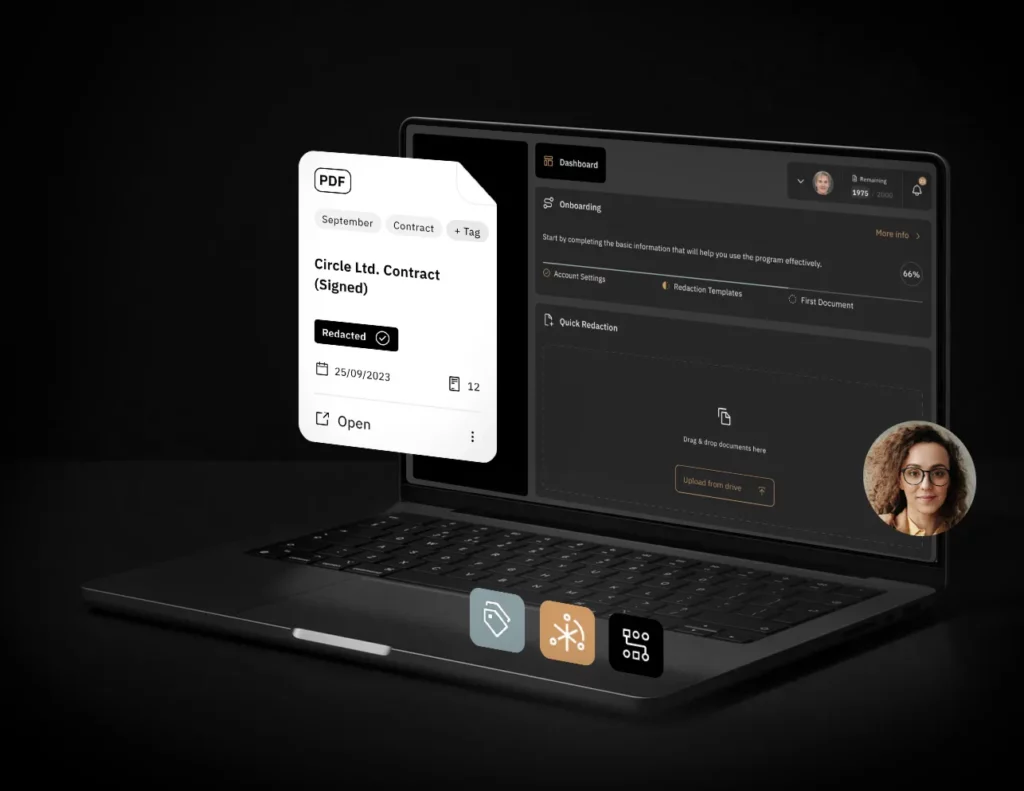Introduction
Document anonymization is the process of removing or masking personal data in such a way that it cannot be linked to a specific individual. In an era of growing privacy concerns and regulations such as RODO, HIPAA and LGPD, effective anonymization has become a key component of an organization’s data security strategy.
On the other hand, more and more companies are moving their processes and resources to the cloud, using SaaS, PaaS and IaaS solutions offered by providers such as Amazon Web Services (AWS), Microsoft Azure or Google Cloud Platform (GCP). This raises the question: is cloud-based document anonymization really secure and effective? What advantages does it bring, and what risks? Is it worth betting on the cloud, or does it still pay to use local (on-premise) solutions?
In this article, we will examine the topic comprehensively, comparing on-premise and cloud-based approaches to anonymization, discussing the technical, legal and organizational aspects, and presenting best practices to maximize security while maintaining high process efficiency.
What is document anonymization?
Anonymization is the process of irreversibly transforming personal data in such a way that it can no longer be linked to a specific person. It differs from pseudonymization, which still allows a person to be identified after applying additional information (such as a key).
In the context of documents, anonymization can take many forms – from redaction, to replacing specific information with random data, to aggregating data into broader categories. It is particularly used in legal, medical, HR, financial or administrative documents.
Cloud computing vs. document processing
Cloud computing has become a cornerstone of modern computing. It enables secure storage of documents, their easy accessibility from anywhere and rapid scaling of resources. Through integrations with a variety of tools and automation, the cloud allows not only to store documents, but also to actively process them, including real-time anonymization.
Of course, this approach raises questions about security – sensitive data must be protected both during transmission and storage. For this reason, encryption, certification and compliance with international regulations are growing in importance.
Comparison of cloud and on-premise in the context of anonymization
Both cloud and on-premise solutions have their justification in terms of document processing and anonymization. However, dynamic market and technological changes mean that it is the cloud that is gaining more and more recognition. The main reasons for it are flexibility, automation, access to the latest solutions and cost predictability.
Scaling
The cloud provides the ability to dynamically scale computing power and disk space according to the organization’s current needs. Thanks to the pay-as-you-go billing model, companies pay only for the actual consumption of resources, which makes it possible to optimize costs without sacrificing efficiency. An advantage of the cloud is also its accessibility – documents can be processed from anywhere in the world, which is crucial for distributed teams and companies operating globally.
Security
Data security in the cloud today stands at a very high level. Leading providers – such as AWS, Azure and GCP – offer advanced security mechanisms: data encryption, multi-factor authentication, activity monitoring, auditing systems and compliance with key regulations, including RODO or ISO 27001. Moreover, many companies would not be able to achieve this level of security in their own on-premise environment.
Application of AI
In the context of anonymization, the cloud allows full use of the capabilities of artificial intelligence and machine learning. This makes it possible not only to automatically detect sensitive data, but also to contextually anonymize it in real time. These processes can be easily integrated with CRM, ERP or workflow systems. For local infrastructure, implementing similar solutions is much more time-consuming and costly.
Acutalizations
Software updates and infrastructure upgrades are other areas where the cloud trumps on-premises solutions. With automatic updates, users gain immediate access to new features and security, without the need for internal IT teams. In the on-premise model, every change requires manual implementation, which not only generates costs, but also risks downtime and errors.
For whom the on-premise version
Of course, there are organizations that still prefer the on-premise model – often due to specific operational considerations, existing infrastructure or management habits. Nevertheless, the direction the industry is heading is clear: cloud dominance.
Why the cloud is gaining popularity
Why are more and more companies opting for the cloud? Primarily because of the need for flexibility, scalability and speed. The cloud eliminates the need to manage physical infrastructure and allows companies to focus on their core business. It gives access to the latest technology, automation, analytics and AI solutions, which significantly accelerates business growth and increases resilience to volatile market conditions.
As a result, for organizations that want to implement a modern, secure and scalable document anonymization system, the cloud is not only a more cost-effective solution, but also a much better fit with today’s business realities. However, in the context of document anonymization, it is cloud solutions that today offer far more options in terms of scalability, cost, integration and technology updates.
The cloud is distinguished above all by its flexibility. Thanks to its ability to dynamically scale resources, it can handle both small volumes of documents and huge collections, without incurring additional investments in hardware. Pay-as-you-go billing models make it possible to control the budget and adapt resource consumption to current needs.
Data security in the cloud
Data security in the cloud also stands at a high level. Providers such as AWS, Azure and GCP offer comprehensive security features: data encryption in transit and at rest, multi-component authentication, automatic backups and compliance with international standards, including ISO 27001 or RODO. Additionally, with monitoring and auditing features, organizations can easily control data flow and identify potential threats.
Automation
In terms of automation, the cloud is also gaining an advantage. Integration with artificial intelligence and machine learning tools makes it possible to detect sensitive data and anonymize it in a contextual manner. As a result, the entire process can be integrated into existing workflow or CRM systems. In on-premise solutions, such capabilities are much more limited – requiring more labor, human and financial resources.
Infrastructure
Infrastructure management and upgrade is another sphere where the cloud shows its superiority. In an on-premise environment, all upgrade activities must be performed manually, increasing the risk of downtime and vulnerability. The cloud, on the other hand, enables automatic updates, minimizing risk and ensuring access to the latest features and security.
Recommendations for organizations
The choice between a cloud and an on-premise solution should be an informed decision based on an analysis of the needs, applicable regulations and technological capabilities of the organization. The cloud has a definite advantage in the case of:
- the need to quickly anonymize a large number of documents,
- lack of its own IT infrastructure,
- The work of geographically dispersed teams,
- The need for integration with modern systems,
- plans to implement artificial intelligence into document processes.
On-premise solutions may remain an option for organizations that need full control over their IT environment for various reasons. However, the direction of market and technology development clearly points to the increasing adoption of cloud solutions as a standard.
Summary
Cloud-based document anonymization is currently the most flexible, scalable and cost-effective solution available on the market. While there are legitimate security and compliance concerns, modern cloud platforms (e.g. BLUUR.ai) can address them effectively, while offering far more capabilities than on-premise solutions.
Choosing the cloud as an environment for document processing and anonymization means access to the latest technology, automation, artificial intelligence and global accessibility without the need to invest in costly infrastructure. This is the future of computing.


